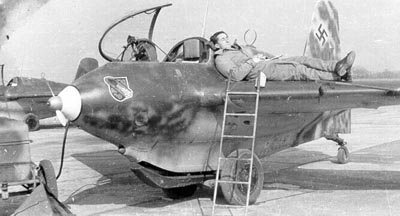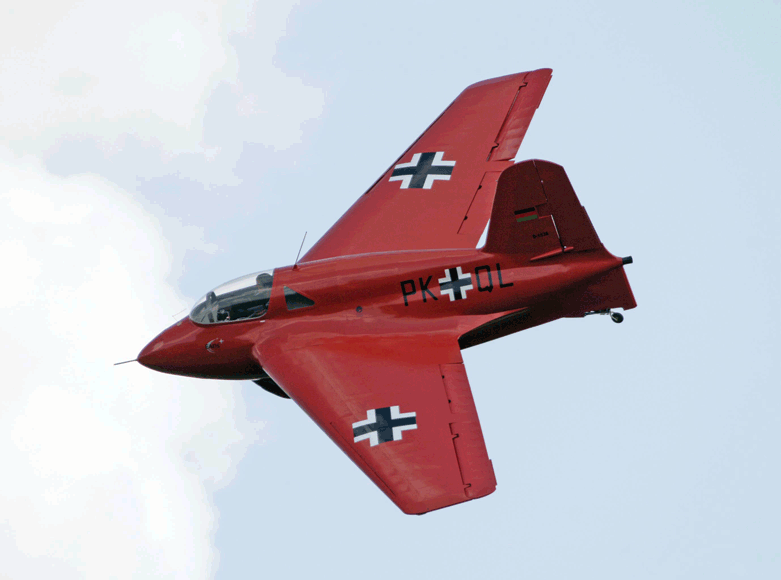Messerschmitt 162
Let’s talk about Messerschmitt’s 163. There were two, The Original Bf 163 and the late war Me 163
Messerschmitt Bf 163
The Messerschmitt Bf 163 was a STOL (Short Take Off and Landing) aircraft designed by BFW and built by Weserflug before World War II. During the autumn of 1935, the considerable potential of the Fieseler Fi 156 project for the tasks of short range reconnaissance and aerial observation had prompted the RLM to draw up a requirement for an army co-operation and observation aircraft with its performance parameters. The Bf 163 followed closely the formula established by the Fi 156 in being a high-wing braced monoplane with a metal structure, automatic leading edge wing slots, double slotted flaps, and an exceptionally tall undercarriage. The aircraft's most interesting feature was the provision for varying the incidence of the entire wing which swivelled on its mainspar, the bracing struts being attached to the fuselage by ball joints and changing their angle with movement of the wing. First flown on 19 February 1938 and powered by the Argus As 10C, the Bf 163 V1 proved to have similar performance characteristics to those of the Fi 156 but was more complex and expensive. Although some components for a second prototype were manufactured, the Bf 163 V2 was not completed and further work on the Bf 163 was terminated in favor of the Fieseler Fi 156, with only a sole prototype being built.
Can’t embed the images here, so here’s an album
Messerschmitt Me 163 Komet
In a very rare decision, the RLM re-issued the airframe designation number 8-163 for the Me 163 Komet rocket-propelled interceptor, after having used the number for the Bf 163. The two aircraft are distinguished by the abbreviation: the earlier Bf 163, and the later Me 163. The new "Me" prefix was adopted for all new designs of Messerschmitt aircraft, after the company's official name of Bayerische Flugzeugwerke (BFW) was changed to Messerschmitt AG, from Willy Messerschmitt's full acquisition of the Bayerische Flugzeugwerke firm on July 11, 1938.
The German Messerschmitt Me 163 "Komet" was perhaps the most unique frontline, operational-level fighter design of World War 2. German engineers, seemingly always on the cutting edge of evolving war technology, developed the rocket-powered aircraft based on early testing completed with an engine-less glider. The resulting research produced the single-seat, swept-wing fighter that was equally dangerous to both enemy bomber crews and the Me 163 pilot alike. Testing occurred at the covert Peenemunde facility in June of 1940 to help prove the concept sound. Despite the motor failing to impress due to reliability issues, the airframe itself handled well in the hands of test pilot Heini Dittmar.
The diminutive Me 163 was piloted by a single crewman housed under a wide clear canopy. The design was given the then-revolutionary concept of swept-back wings mounted along each fuselage side. The fuselage was a stout, portly design intended to house the cockpit and necessary fuel stores. The empennage was capped by a simple vertical tail fin lacking any horizontal planes. Take-off for the Me 163 was achieved by way of a wheeled, unsprung "dolly" assembly with the rocket motor at full thrust. The dolly was then jettisoned immediately after take-off for it proved an unnecessary counter-aerodynamic element. The interceptor then climbed to the required attack altitude to meet the incoming enemy bomber formation, most likely expending all of its fuel supply by this time. From its lofty perch, the accepted tactic for the Me 163 became a high-speed swoop down into the bomber formation, engaging targets with cannon for as long as momentum allowed - usually two or three dives though each swipe at the target was managed through a quick three-second-or-less window of opportunity. Once spent of both fuel and ammunition, the Komet was then glided to the ground under basic physics, landing on a relatively smooth patch of earth atop the provided spring-loaded centerline skid. In theory, the idea of a small, one-man interceptor tearing holes in unsuspecting bomber formations was a sound one as defending Allied escort fighter aircraft could only hope to catch the Me 163, a target reaching speeds of nearly 600 miles per hour. However, the reality of the design provided an array of dangers for the pilot. The fuel mixture itself was known to self-combust as both elements were highly volatile, proven by the fact that such an event killed a test pilot - the aircraft had the possibility of exploding in the air or on the ground. The airframe could also become highly uncontrollable at the provided extreme speeds for swept wings were still an infant concept concerning high-speed flight. Powered flight was essentially limited to just 7.5 minutes through the available fuel stores and the freefall glide to the ground during landing placed the pilot and his aircraft in a precariously vulnerable position when Allied fighters were about. Unpowered landings also held its own share of inherent dangers as only a single attempt was essentially allowed. The operational range of the Me 163 also proved extremely limited and restricted the German response. Additionally, the armament array of 2 x cannons (mounted in the wing roots) was afforded up to 60 rounds of ammunition per weapon installation
At the end of 1944, 91 aircraft had been delivered to JG 400 but a continuous lack of fuel had kept most of them grounded. It was clear that the original plan for a huge network of Me 163 bases was never going to be realized. Up to that point, JG 400 had lost only six aircraft due to enemy action. Nine were lost to other causes, remarkably few for such a revolutionary and technically advanced aircraft. In the last days of the Third Reich the Me 163 was given up in favor of the more successful and threatening Me 262. In May 1945, Me 163 operations were stopped, the JG 400 disbanded, and many of its pilots sent to fly Me 262s. In any operational sense, the Komet was a failure. 300 aircraft were built, but the Komet proved ineffective as a fighter and was responsible for the destruction of only about nine Allied aircraft. (16 air victories for 10 losses, according to some sources.)
Comment has been collapsed.
Comment has been collapsed.
[Humble Bundle] March 2025 Humble Choice (#64) ♠️
330 Comments - Last post 7 minutes ago by Bin246
[Steam] List of paid-now-free games of 2024 (Fr...
294 Comments - Last post 28 minutes ago by GraVe23
Prime Game keys to y'all
223 Comments - Last post 1 hour ago by Kingsajz
[Indiegala] RoboCop: Rogue City (90% off | Hist...
105 Comments - Last post 1 hour ago by Chris76de
[Fanatical] KingSlayer Bundle (Spring 2025) 🐶
34 Comments - Last post 3 hours ago by Formidolosus
Where are those giveaways coming from?
16,725 Comments - Last post 3 hours ago by Kenruyoh
[itch.io] California Fire Relief Bundle (DRM-Free)
49 Comments - Last post 5 hours ago by wigglenose
Today is my Birthday...
67 Comments - Last post 1 minute ago by HowDareYou
March is not a month, it's a MEGAEVENT ( Day 12 )
1,433 Comments - Last post 3 minutes ago by lesik
Cakeday
51 Comments - Last post 5 minutes ago by pizzahut
👥 TalePlay (TalePlay) - Giveaway Group
1,605 Comments - Last post 8 minutes ago by Vasharal
Welcome to Germany! 🇩🇪 Enter here for a new mon...
136 Comments - Last post 9 minutes ago by DrPower
Orphan keys drop thread
29,719 Comments - Last post 48 minutes ago by Kingsajz
Official last movie you saw thread
9,940 Comments - Last post 1 hour ago by Myklex









http://www.steamgifts.com/giveaway/tzgQu/septerra-core
Comment has been collapsed.